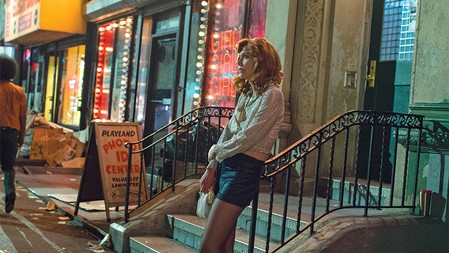‘The Deuce’ Team Talks Recreating 1970s New York City
By Andrea Reiher
LOS ANGELES (Variety.com) – In the first season of HBO’s “The Deuce,” Eileen “Candy” Merrell (Maggie Gyllenhaal) goes from a Times Square prostitute to an entrepreneurial pornography director. Getting there, however, is not easy. As a prostitute, she tries to have control over her life by refusing to work for a pimp, even when Rodney (Method Man) tries to woo her away from her independent life with promises of protection from johns who physically abuse her. In a pivotal episode five scene, Rodney is both charming and menacing, smooth and brutal as he tries to persuade Candy to join him, and she tries to escape. It’s a dynamic the creators say grew very organically out of giving the actors space to experiment and play in — a feat that was also not easy because of what behind-the-scenes work went into creating a realistic New York City street of 45 years ago.
Scott Dougan
Art Director
“We went through looking at old photographs and old movies, and from those we built a storefront-by-storefront re-creation — everything from the sign of the store down to the ground, the garbage and everything, that was real. The transformation takes place piece by piece, so you go to a storefront, you say, ‘OK, we’re going to make a sex shop and a playland arcade and a bookstore and a cigar place and which one of those can this place be?’ Then you do the signage and the neon and the branding.”
Anna Terrazas
Costume Designer
“One of the things that we saw in the research from that era — in terms of women working on the street — is that they didn’t necessarily have to look like prostitutes. Some of them were wearing long dresses or pants, so that was one thing we found pretty interesting. The big challenge was to make it look real and not to make it look like when you think of the 1970s and it’s really exaggerated. We just really wanted to portray what was happening in New York in Times Square at that time.”
Uta Briesewitz
Director
“It was all about performances and keeping the camera in on the performances. This is why we’re shooting on Steadicam — so we can be as mobile as possible. It was total freedom for the actors and just catching it on camera. This was not a moment that needed clever visual shots for it. It was more like giving them a stage and giving them an option to have a moment of rest or retreating back to the wall and then breaking through from that moment again.”
Nina Noble
Executive Producer
“The way [New Yorkers] carry themselves and the way they understand living in a very densely populated place — we had to re-create the space physically, but we also had to capture the character of the people and that was important to us. …The one thing we kept bumping up against is the number of trees in New York now as opposed to then. Neighborhoods are a lot more green now. We even entertained the idea of shooting in Boston.”
Vanja Cernjul
Director of Photography
“We were very careful to make the older practical light sources as real as possible. As often as possible we would use the actual light sources — the real neon signs from the ‘70s, for example. We wanted to get the color of the streets correct. In the ‘70s in New York, the streets were lit mostly with the mercury bulbs, they had the greenish-cyan glow that these street lights gave off, and we wanted to capture that.”

